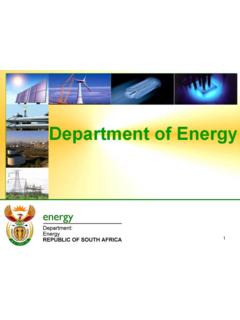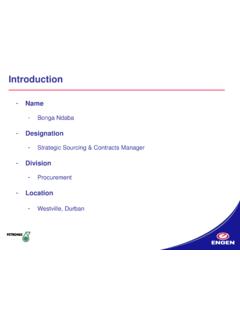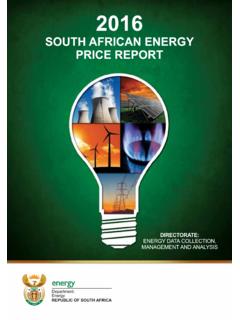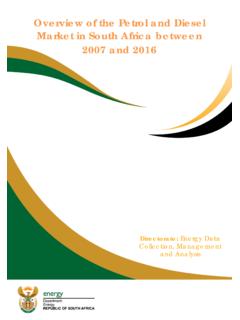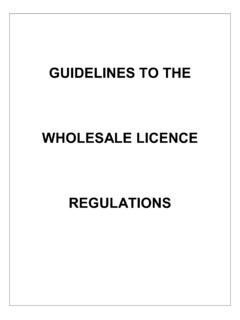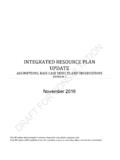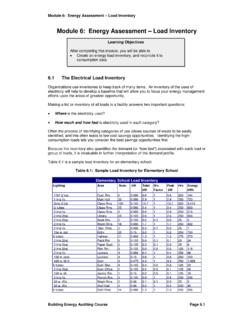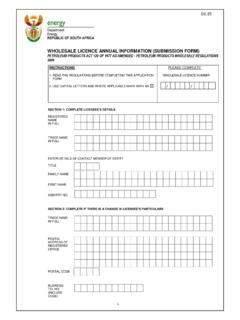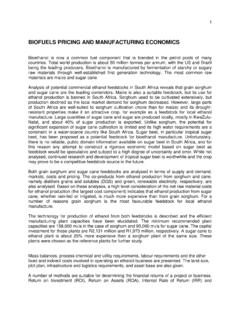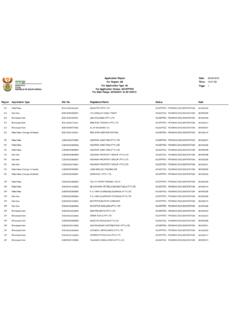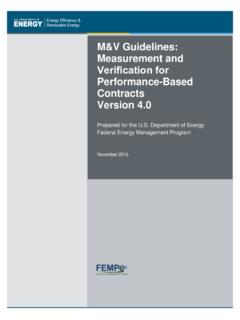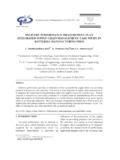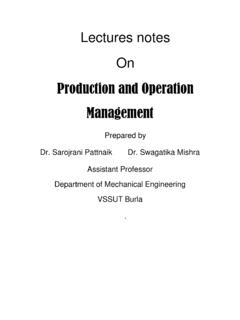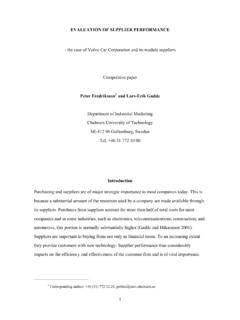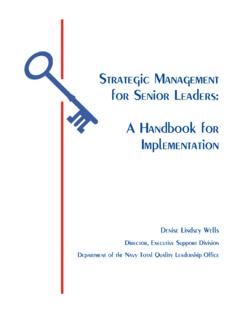Transcription of Module 7: Energy Monitoring, Targeting & Reporting
1 Energy Monitoring, Targeting & Reporting Industrial Energy management Training Course Page 7-1 Module 7: Energy Monitoring, Targeting & Reporting Energy information management is the next issue raised in the Energy management matrix, and it is especially important as a component of any effective Energy management strategy. The experience of industries in Canada and the UK, for example, is that monitoring, Targeting and Reporting (MT&R) alone can lead to significant Energy reductions. This Module develops a practical working knowledge of the techniques known as MT&R, including the computational methods used to correlate Energy consumption to the key Energy use drivers such as production, the analysis of consumption patterns using the CUSUM technique, the determination of reduction targets, and the development of control mechanisms for production-floor management of performance . A Rationale for Monitoring, Targeting and Reporting (MT&R) There are many ways for industrial companies to improve their Energy performance .
2 These typically include: Why look back? The Energy used by any business varies as production processes, volumes, and inputs vary. Determining the relationship of Energy use to key performance indicators will allow you to determine: Whether your current Energy use is better or worse than before; Trends in Energy consumption that reflect seasonal, weekly, and other operating patterns; How much your future Energy use is likely to vary if you change aspects of your business; Specific areas of wasted Energy Comparisons with other businesses with similar characteristics. This benchmarking process will provide valuable indications of the effectiveness of your operations as well as an indication of Energy use; How your business reacted to changes in the past; How to develop performance targets for an Energy management program. Source: Energy -wise Practice 12, NZ Energy Efficiency and Conservation Authority Module 7 Learning Objectives After completing this Module , you will Understand how MT&R can produce the information you need to manage your Energy consumption downward; Appreciate the immediate actions that you can take to better understand the information that can be derived from existing Energy data.
3 Describe the difference in purpose and activity of M&V and M&T Energy Monitoring, Targeting & Reporting Page 7-2 Industrial Energy management Training Course Identification of savings opportunities through Energy surveys or audits, involving the physical inspection of plant facilities and process equipment; Employee-focused activities, such as campaigns to increase awareness, motivation and involvement in Energy management activities throughout the company; Organisational practices, such as the formulation of policy, the assignment of Energy responsibilities, the provision of training, etc. facility and process retrofits, incorporating more efficient technology; Implementation of operational and maintenance practices that take into account the Energy efficiency impacts. MT&R is not a substitute for these actions, but it does complement them. It can often provide useful information when implementing these other approaches, thus making them more effective.
4 It also closes the accountability loop by providing feedback on performance improvement measures that have been implemented, even to the point of assessing the return on investment in terms of savings achieved. Increasingly used in Canada, monitoring and Targeting has a long history in the UK, having been launched as a national program in 1980. Over 50 industry sector studies have demonstrated the benefits of monitoring and Targeting repeatedly. These benefits include: Energy cost savings, typically 5 to 15% as a direct consequence of the MT&R program, with concomitant reductions in emissions of CO2 and other pollutants; Co-ordination of Energy management policy, through Targeting of initiatives that achieve the maximum benefit, and sustaining savings over the long term; Assisting with the acquisition of financing for Energy efficiency projects, through the accurate determination of baseline Energy use levels for Energy efficiency project proposals, and verification of savings; Improved product and service costing, by the definition of the Energy content of products and services; Improved budgeting, by providing a basis for the more accurate projection of future Energy use for given levels of activity; Better preventative maintenance, by increasing the availability of performance data on Energy systems.
5 Improved product quality, by increasing the level of control on production processes; Waste avoidance, by the extension of the principles of MT&R to other environmental management issues, such as water consumption, materials management , plant downtime, and so on. MT&R is the management information basis for achieving Energy efficiency gains. Energy Monitoring, Targeting & Reporting Industrial Energy management Training Course Page 7-3 A Case Study: Toray Textiles (Europe) Ltd. The Bulwell factory of Toray Textiles (Europe) has been a textile plant since the 19th century. The site produces around 20 million metres of fabric per year, with a sales value of 40 million, and employs about 200 staff. Operations on the site include scouring, bleaching and dyeing; three open-width scouring machines, 18 pressurised jet dyeing machines and two stenters are used. Toray Textiles acquired the site in 1989 and initiated a major Energy efficiency drive.
6 Over the period 1989 - 1993 the site achieved an Energy reduction of 27%, with half of the savings being generated through measures involving little or no capital expenditure. The new Energy management programme was based on: Monitoring & Targeting ; staff motivation, training; good housekeeping; modem management techniques; capital investment. In the new programme, the site's engineering manager was responsible for collecting weekly Energy consumption data. These were then indexed to production to give a measure of Energy efficiency. Involvement of all staff was seen to be crucial to the success of the Energy -saving programme. Toray Textiles set up Small Group Activities that were based on management and workforce meeting regularly to discuss problems and suggest improvements. This approach has had a significant impact on reducing Energy use, in particular through good housekeeping and the identification of the following major Energy -saving projects: heat recovery from the scouring machines; insulation of dyeing vessels: economisers for boiler feed water; improvements in condensate return system; inverter drives on various machines.
7 The Monitoring and Targeting system used Energy data from steam, electricity and water meters. The engineering manager was able to use the system to: track Energy performance ; monitor overall Energy savings (using CUSUM) and determine the contribution made by specific Energy efficiency actions to these overall savings. By December 1993, the Energy management initiatives implemented by Toray Textiles had saved nearly 75 million kWh. This equates to about one year's Energy consumption for the site and is clearly significant in terms of the company's operating costs and profits. Source: Good Practice Guide 148: Monitoring and Targeting in the textiles industry, UK Best Practice Programme Energy Monitoring, Targeting & Reporting Page 7-4 Industrial Energy management Training Course The Scope and Information Sources for MT&R Depending on the nature of your organisation, there may be available, or obtainable, a hierarchy of information related to Energy use with levels such as the following: Plant level information can be derived from financial accounting systems the utilities cost centre.
8 Plant Department information can be found in comparative Energy consumption data for a group of similar facilities, utility billings, service entrance meter readings, building management system data, correlated with building use and production data. System (for example, boiler plant) performance data can be determined from sub-metering data, subjected to regression analysis against key independent variables. Equipment level information can be derived from nameplate data, run-time and schedule information, sub-metered data on specific Energy consuming equipment. The important point to be made here is that all of these data are useful; all can be processed to yield information about facility performance . It is only after cataloguing the available data, that decisions should be made about taking steps to augment the database. The scope of MT&R is also a function of its purpose. If Energy monitoring is being implemented to verify savings in the context of internal accounting or third-party Energy performance contracting requirements, the scope of the program also needs to take into account: Acceptable levels of uncertainty, in view of the reality that all data are subject to error and that Energy consumption is typically impacted by a complex of factors; Cost of implementation, in recognition of the fact that additional measurement has a cost both the measurement technology and time costs for personnel and that the cost needs to be a reasonable proportion of the overall savings achieved; The complexity of Energy use variables, or the degree to which certain factors can be safely assumed to be constant or inconsequential; The number of Energy saving measures being monitored, and whether the impact of each separately or all collectively is of importance.
9 Often these issues are more important in the context of measurement and verification of savings for Energy performance contracting. Definitions Energy monitoring, target setting, and Reporting (MT&R) is the activity which uses information on Energy consumption as a basis for control and managing consumption downward. The three component activities are distinct yet inter-related: Monitoring is the regular collection of information on Energy use. Its purpose is to establish a basis of management control, to determine when and why Energy consumption is deviating from an established pattern, and as a basis for taking management action where necessary. Monitoring is essentially aimed at preserving an established pattern. Energy Monitoring, Targeting & Reporting Industrial Energy management Training Course Page 7-5 Target setting is the identification of levels of Energy consumption, which is desirable as a management objective to work toward.
10 Reporting involves closing the loop by putting the management information generated from the monitoring process in a form that enables ongoing control of Energy use, the achievement of reduction targets, and the verification of savings. Monitoring and target setting have elements in common and they share much of the same information. As a general rule, however, monitoring comes before target setting because without monitoring you cannot know precisely where you are starting from, or decide if a target has been achieved. The Reporting phase not only supports management control, but also provides for accountability in the relationship between performance and targets. Data and information Within the activity of M&T, data and information are distinct entities. The activity of monitoring a facility , system or process encompasses both measurement and analysis. Data are raw numbers such as would be the result of a measurement .
